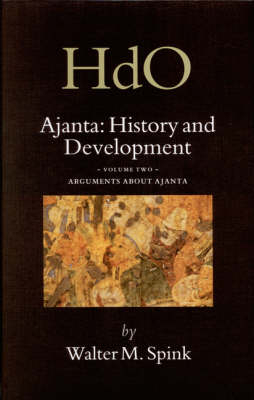
Ajanta: History and Development, Volume 2 Arguments about Ajanta
Seiten
2006
Brill (Verlag)
978-90-04-15072-0 (ISBN)
Brill (Verlag)
978-90-04-15072-0 (ISBN)
This volume in Brill’s renowned Ajanta series discusses contentious views on Ajanta’s development, the often-dramatic changes in patronage, and the intriguing problem of why Ajanta’s original (Hinayana) caves were not refurbished by the Vakataka. A comprehensive appendix on Ajanta inscriptions is also included.
Volume Two begins with writings by some of the most important critics of Walter Spink's conclusions, interspersed with his own responses, using a thorough analysis of the great Cave 26 to support his assertions. The author then turns to matters of patronage, and to the surprising fact that, unlike most other Buddhist sites, Ajanta was purely "elitist", developed by less than a dozen major patrons. Its brief heyday traumatically ended, however, with the death of the great emperor Harisena in about 477, creating political chaos. Ajanta's anxious patrons now joined in a headlong rush to get their shrines dedicated, in order to obtain the expected merit, before they fled the region, abandoning their caves to the monks and local devotees remaining at the now-doomed site. These "intrusive" new patrons now filled the caves with their own helter-skelter votive offerings, paying no heed to the well-laid plans of the years before. A similar pattern of patronage is to be found in the redecoration of the earlier Hinayana caves, where the careful planning of the work being done during Harisena's reign is suddenly interrupted by a host of individual votive donations. The volume ends with a new and useful editing of Ajanta inscriptions by Richard S. Cohen.
Volume Two begins with writings by some of the most important critics of Walter Spink's conclusions, interspersed with his own responses, using a thorough analysis of the great Cave 26 to support his assertions. The author then turns to matters of patronage, and to the surprising fact that, unlike most other Buddhist sites, Ajanta was purely "elitist", developed by less than a dozen major patrons. Its brief heyday traumatically ended, however, with the death of the great emperor Harisena in about 477, creating political chaos. Ajanta's anxious patrons now joined in a headlong rush to get their shrines dedicated, in order to obtain the expected merit, before they fled the region, abandoning their caves to the monks and local devotees remaining at the now-doomed site. These "intrusive" new patrons now filled the caves with their own helter-skelter votive offerings, paying no heed to the well-laid plans of the years before. A similar pattern of patronage is to be found in the redecoration of the earlier Hinayana caves, where the careful planning of the work being done during Harisena's reign is suddenly interrupted by a host of individual votive donations. The volume ends with a new and useful editing of Ajanta inscriptions by Richard S. Cohen.
Walter M. Spink, Ph.D. (1954) at Harvard is Professor Emeritus, History of Art, at the University of Michigan, Ann Arbor. He has published widely on Indian Art in general, and Ajanta and related sites in particular.
| Erscheint lt. Verlag | 1.5.2006 |
|---|---|
| Reihe/Serie | Handbook of Oriental Studies. Section 2 South Asia / Ajanta: History and Development ; 18/2 |
| Verlagsort | Leiden |
| Sprache | englisch |
| Maße | 155 x 235 mm |
| Gewicht | 660 g |
| Themenwelt | Kunst / Musik / Theater ► Kunstgeschichte / Kunststile |
| Geisteswissenschaften ► Archäologie | |
| Geisteswissenschaften ► Religion / Theologie ► Buddhismus | |
| Technik ► Architektur | |
| ISBN-10 | 90-04-15072-2 / 9004150722 |
| ISBN-13 | 978-90-04-15072-0 / 9789004150720 |
| Zustand | Neuware |
| Haben Sie eine Frage zum Produkt? |
Mehr entdecken
aus dem Bereich
aus dem Bereich
Philosophische Betrachtungen
Buch | Softcover (2024)
Aufbau TB (Verlag)
CHF 20,95
Unterweisungen in Zen-Meditation
Buch | Hardcover (2024)
Arkana (Verlag)
CHF 29,90


